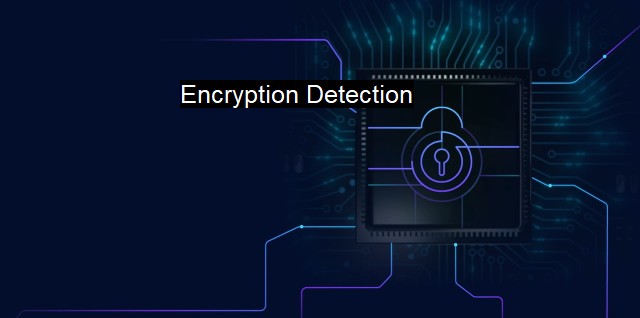What is Encryption Detection?
Ensuring Secure Networks: Decrypting the Details of Encryption Detection in Cybersecurity
Encryption Detection involves identifying cryptographic algorithms in use over a network or within a system, seeing encrypted activities, or for recognizing or unveiling the cipher protocol. The purpose of encryption detection is creating a secure digital environment, preventing unauthenticated disruption, ensuring data integrity, and safeguarding data confidentiality.It is crucial to recognize that cybercriminal activity increasingly incorporates encryption to camouflage hacking intentions and exercises. Thus, detecting and decrypting encoded text becomes an important facet of cybersecurity. Encryption detection, therefore, can help cybersecurity professionals prevent potential threats from encrypted cyber-attacks and protect sensitive data.
Encryption detection applies in various ways when it comes to data protection. Cybersecurity engineers implement it to detect malicious encrypted traffic over the network that is hard to track. although HTTPS is undoubtedly essential for secure communication and privacy perception, it usually provides a perfect camouflage for stealthy malicious activities. That's where encryption comes into play. It examines and identifies the encryption algorithms, providing laying bare any sinister motives, and granting cybersecurity professionals better visibility of the concealed threats.
Importantly, encryption detection forms a critical part of antivirus algorithms too. Antiviruses use encryption detection techniques to identify the presence of codes or contents hidden within an encryption. When malware attempts to sneak into a system quietly by encrypting itself, the antivirus tracks it down through its unique encryption detection technique. Uncovering the hidden malware enhances the capability of the antivirus, allowing it to provide more secure defenses for systems and data integrity.
One crucial aspect to address here is the valuable role encryption detection plays in combating Ransomware – a type of malicious software designed to block access to a computer system until a sum of money is paid. Ransomware often uses sophisticated encryption codes hard to break, but effective encryption detection provides the potential feasibility of identifying ransomware's malicious activities even before the cyber offender executes them.
Encryption detection comes with its challenges. The enormous increment of encryption-depended web traffic and the sophisticated evolving methodologies employed by cybercriminals make detection complicated. encrypted traffic cannot be reviewed without identification, restricting potential threat detection. Many businesses are reluctant to introduce encryption detection software due to concerns about privacy regulation issues.
Yet despite these challenges, encryption detection remains a critical cog in the cybersecurity framework. Where evasion is the name of the game in modern threats, being able to identify and act on those disguised under encryption takes precedence in any defensive strategy. After all, the ultimate goal of encryption detection is to protect upwards of validating encrypted communication's integrity.
Further, without effective encryption detection, organizations run the risk of becoming easy prey for different types of hidden malware without warning. The onus, therefore, is on companies, organizations, and cybersecurity professionals to develop and deploy efficient and effective encryption detection systems capable of giving them an advantage in this ongoing battle against cybercrime.
Encryption detection is an essential technique to maintain cybersecurity. In the face of rising sophisticated encrypted cyber-attacks and ransomware, traditional defense mechanisms can overlook potential threats camouflaged in the intricate coding algorithms. The importance of encryption detection has become increasingly prevalent. While the detection itself may pose certain privacy issues, the lack of it significant risks, including data breach and potential loss of proprietary data. Thus, while encryption detection isn't straightforward or easy, its necessity in our cyber-dependent world cannot be overstated.

Encryption Detection FAQs
What is encryption detection?
Encryption detection is a cybersecurity technique that is used to identify encrypted data being transmitted over networks or stored on devices. It involves analyzing the traffic or data to determine if it is encrypted, and if so, what type of encryption is being used.Why is encryption detection important for antivirus?
Encryption detection is an important feature of antivirus software because it can help identify and block malware that is using encryption to hide its presence. Many types of malware use encryption to avoid detection by traditional antivirus programs, so encryption detection can help detect these threats and prevent them from infecting a device.How does encryption detection impact privacy?
Encryption detection can have both positive and negative impacts on privacy. On one hand, it can be used to identify attempts to intercept or spy on encrypted communications, which can help protect privacy. On the other hand, some encryption detection methods may be seen as invasive, as they involve analyzing and potentially intercepting encrypted data. It is important for organizations to use encryption detection tools responsibly and transparently to balance security and privacy considerations.What challenges are associated with encryption detection?
One of the main challenges of encryption detection is the increasing use of advanced encryption algorithms that are difficult to crack. This means that traditional encryption detection methods may not be effective in detecting some types of encrypted data. Additionally, encryption detection can be resource-intensive and may slow down network performance if not implemented correctly. Finally, there are concerns around privacy and the potential for encryption detection to be used for surveillance or censorship purposes.| | A | | | B | | | C | | | D | | | E | | | F | | | G | | | H | | | I | | | J | | | K | | | L | | | M | |
| | N | | | O | | | P | | | Q | | | R | | | S | | | T | | | U | | | V | | | W | | | X | | | Y | | | Z | |
| | 1 | | | 2 | | | 3 | | | 4 | | | 7 | | | 8 | | |||||||